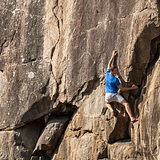Sector Huvudväggen:
The quality of this 10-15 meter high crag is sometimes excellent. A concentrated number of bolted medium-difficult climbs and a clean-cut dihedral (own gear) can contribute to a fun-filled visit. The face is with some exceptions just below vertical and refined footwork is more important than large biceps. Prepare yourself for some intense technical face climbing and a feeling that some old climbs are sandbagged. This crag would be much more popular if it were located in a natural environment and not so close to Huddingevägen. In terms of climbing it's well worth a visit and if you go here early in the morning it can be quite warm in the sun, and in the afternoon you can enjoy some cool climbing in the shadow on hot summer days. The bolting is quite ok although not top-notch by modern standards (a clipstick is recommended). The parking is just 30 meters from the wall.
Sometimes the ground is filled with sand or soil below the right part of the wall, but it is usually removed fairly quickly.
Sector Pytteväggen:
This is a small nice slightly overhanging wall located high up 40 meters to the left of the main wall, clearly visible down from the road. Nice rock quality, but there is some moss in this sector and some trees in front of the wall.
Environment:
East Northeast. Open location. Sun in the morning and shade (after one o'clock) in the afternoon/evening. Suburban surroundings with some kind of gravel storage by the wall. Huddingevägen is 60 meters away and sounds quite loud which means that it can be difficult to hear each other when you are high up on the wall.



